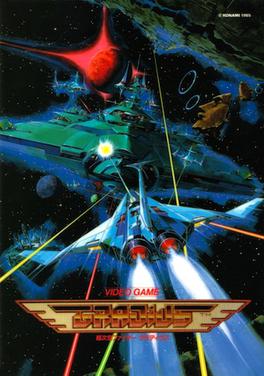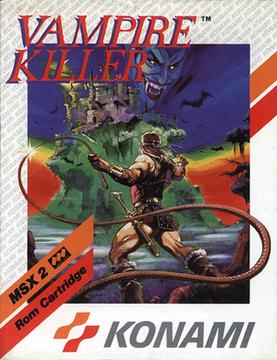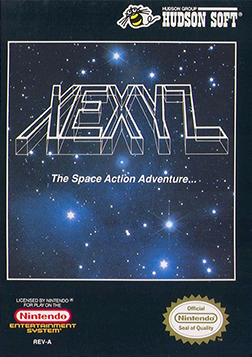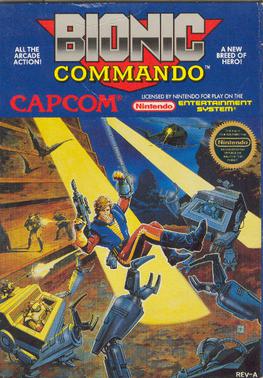
Gradius is a side-scrolling shooter video game developed and published by Konami. The first game in the Gradius series, it was originally released as a coin-operated arcade game in 1985. The player maneuvers a spacecraft known as the Vic Viper that must defend itself from the various alien enemies. The game uses a power-up system called the "power meter", based upon collecting capsules to purchase additional weapons.
TwinBee (ツインビー) is a video game series composed primarily of cartoon-themed vertical-scrolling shoot-'em-up games produced by Konami that were released primarily in Japan. The series originated as a coin-operated video game simply titled TwinBee in 1985, which was followed by several home versions and sequels. The character designs of almost every game in the series since Detana!! TwinBee in 1991 were provided by Japanese animator Shuzilow HA, who also planned and supervised most of the subsequent installments in the TwinBee series. The series also inspired a radio drama adaptation that lasted three seasons in Japan, as well as an anime adaptation.

Castlevania II: Simon's Quest is a 1987 action role-playing game developed and published by Konami. It was originally released in Japan in 1987 for the Famicom Disk System, and in North America in 1988 for the Nintendo Entertainment System. It is the second Castlevania game released for the NES, following the original Castlevania (1986). Set seven years after the events of the first installment, the player once again assumes the role of vampire hunter Simon Belmont, who is on a journey to undo a curse placed on him by Dracula at the end of their previous encounter. Dracula's body was split into five parts, which Simon must find and bring to the ruins of Castle Dracula in order to defeat him. The game deviates from the traditional platforming of its predecessor, incorporating role-playing and open world elements.

Vampire Killer, known in Japan as Akumajō Dracula, is a 1986 platform game developed and published by Konami for the MSX2. It is a parallel version of the original Castlevania, which debuted a month earlier for the Famicom Disk System under the same Japanese title. However, the MSX2 version was localized first in Europe and was published without the Castlevania branding that the franchise would start using abroad in 1987 when the NES version was released in North America. It was released on the Wii U's Virtual Console on December 17, 2014, in Japan.

Multi-memory controllers or memory management controllers (MMC) are different kinds of special chips designed by various video game developers for use in Nintendo Entertainment System (NES) cartridges. These chips extend the capabilities of the original console and make it possible to create NES games with features the original console cannot offer alone. The basic NES hardware supports only 40KB of ROM total, up to 32KB PRG and 8KB CHR, thus only a single tile and sprite table are possible. This limit was rapidly reached within the Famicom's first two years on the market and game developers began requesting a way to expand the console's capabilities.

Hudson's Adventure Island, known as Takahashi Meijin no Bōken Jima in Japan and also known as Adventure Island, is a side-scrolling platform game produced by Hudson Soft that was released in Japan for the Famicom and MSX on September 12, 1986. Adventure Island was released in North America for the Nintendo Entertainment System in 1988 and in the PAL region in 1992.

Bio Miracle Bokutte Upa is a Konami video game that was first released for a Japan-exclusive market in 1988 for the Family Computer Disk System. It was later released as a cartridge in 1993 for the Family Computer itself.
Gradius is a series of shooter video games, introduced in 1985, developed and published by Konami for a variety of portable, console and arcade platforms. In many games in the series, the player controls a ship known as the Vic Viper.

The Goonies is a 1986 platform game based on the film of the same name produced by Konami for the Family Computer. Konami also developed a completely different version for the MSX in Japan. First released on cartridge, it was later re-released in Disk System format in 1988.

Konami Wai Wai World, "wai wai" being a Japanese onomatopoeia expressing a noisy or boisterous atmosphere, is a 1988 Family Computer platform video game released only in Japan by Konami. The game itself stars various Konami-created characters as well as Mikey and King Kong, who appeared in two Konami-produced, film-based games.

Wai Wai World 2: SOS!! Parsley Jō is a 1991 Famicom platform game released only in Japan by Konami. It is a sequel to Konami Wai Wai World, and stars various Konami characters. It was also re-released for the Wii U Virtual Console on September 2, 2015 in Japan.

Getsu Fūma Den is an action role-playing video game developed and published by Konami for the Family Computer in 1987 exclusively in Japan. It has been referenced in many subsequent Konami titles throughout the years. The game is structurally similar to Castlevania II: Simon's Quest, The Goonies II and Teenage Mutant Ninja Turtles (NES).

Xexyz, known in Japan as Kame no Ongaeshi - Urashima Densetsu, is a 1988 video game published by Hudson Soft for the Nintendo Entertainment System. The game was released in Japan on August 26, 1988, and saw a North American release sometime in April 1990. The game was never released in Europe and the game is not playable on PAL consoles.

Miracle Warriors: Seal of the Dark Lord, known as Haja no Fūin in Japan, is a role-playing video game released initially on the Japanese PC-88 and then ported to various other systems, including a Master System port developed by Sega, which was released internationally.

Bionic Commando, originally released as Hitler's Resurrection: Top Secret in Japan, is a platform game released by Capcom for the Family Computer and Nintendo Entertainment System in 1988. It is based on the 1987 arcade game Bionic Commando.

Super Contra, known as Super Contra: The Alien Strikes Back in Japan, is a run and gun video game by Konami, originally released as a coin-operated arcade video game in January 1988. It is the sequel to the original Contra and part of the Contra series. The game stars Bill Rizer and Lance Bean as they are sent to thwart another alien invasion from the vicious Red Falcon.

Castlevania, known in Japan as Akumajō Dracula, is a 1986 action-platform game developed and published by Konami. It was originally released in Japan for the Famicom Disk System in September 1986, before being ported to cartridge format and released in North America for the Nintendo Entertainment System (NES) in March 1987 and in Europe in 1988. It was also re-issued for the Family Computer in cartridge format in 1993. It is the first installment in the Castlevania series.

Metal Gear is an action-adventure stealth video game developed and published by Konami for the MSX2. It was released for the system in Japan and parts of Europe in 1987. Considered to have popularized the stealth game genre, it was the first video game to be fully developed by Hideo Kojima, who would go on to direct most of the games that followed in the Metal Gear series. A reworked port of the game was released for the Famicom a few months later, which later saw release in international markets for the NES over the following two years; this version was developed without Kojima's involvement and features drastically altered level designs, among other changes.

Double Dragon II: The Revenge is a side-scrolling beat-'em-up produced for the Nintendo Entertainment System in late 1989. It is the second Double Dragon game for the NES and was published in North America by Acclaim Entertainment, who took over publishing duties from Tradewest. Accalim also published it in PAL regions. The game shares its title with the 1988 arcade sequel to the original Double Dragon, using the same promotional artwork for its packaging and having a similar plot, but the content of the two games are otherwise drastically different. The NES version of Double Dragon II was directed by Hiroyuki Sekimoto, with the arcade version's director Yoshihisa Kishimoto taking a supervisory role in the game's development.


















